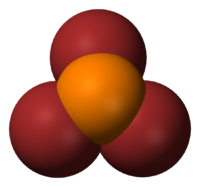
Phosphorus tribromide
Background to the schools Wikipedia
SOS Children, an education charity, organised this selection. Child sponsorship helps children one by one http://www.sponsor-a-child.org.uk/.
| Phosphorus tribromide | |
|---|---|
 |
|
 |
|
|
Phosphorus tribromide |
|
|
Other names
phosphorus(III) bromide, |
|
| Identifiers | |
| CAS number | 7789-60-8 |
| PubChem | 24614 |
| ChemSpider | 23016 |
| EC number | 232-178-2 |
| RTECS number | TH4460000 |
| Jmol-3D images | Image 1 |
|
SMILES
|
|
|
InChI
|
|
| Properties | |
| Molecular formula | PBr3 |
| Molar mass | 270.69 g/mol |
| Appearance | clear, colourless liquid |
| Density | 2.852 g/cm3 |
| Melting point |
-41.5 °C (231.7 K) |
| Boiling point |
173.2 °C (446.4 K) |
| Solubility in water | rapid hydrolysis |
| Refractive index (nD) | 1.697 |
| Viscosity | 0.001302 Pas |
| Structure | |
| Molecular shape | trigonal pyramidal |
| Hazards | |
| MSDS | External MSDS |
| EU Index | 015-103-00-6 |
| EU classification | Corrosive (C) |
| R-phrases | R14, R34, R37 |
| S-phrases | (S1/2), S26, S45 |
| NFPA 704 | |
| Related compounds | |
| Other anions | phosphorus trifluoride phosphorus trichloride phosphorus triiodide |
| Other cations | nitrogen tribromide arsenic tribromide antimony tribromide |
| Related compounds | phosphorus pentabromide phosphorus oxybromide |
| Supplementary data page | |
| Structure and properties |
n, εr, etc. |
| Thermodynamic data |
Phase behaviour Solid, liquid, gas |
| Spectral data | UV, IR, NMR, MS |
| Except where noted otherwise, data are given for materials in their standard state (at 25 °C, 100 kPa) |
|
| Infobox references | |
Phosphorus tribromide is a colourless liquid with the formula PBr3. It fumes in air due to hydrolysis and has a penetrating odour. It is widely used in the laboratory for the conversion of alcohols to alkyl bromides.
Preparation
PBr3 is prepared by treating phosphorus with bromine. An excess of phosphorus is used in order to prevent formation of PBr5:
Reactions
Phosphorus tribromide, like PCl3 and PF3, has both properties of a Lewis base and a Lewis acid. For example, with a Lewis acid such as boron tribromide it forms stable 1:1 adducts such as Br3B-PBr3. At the same time PBr3 can react as an electrophile or Lewis acid in many of its reactions, for example with amines.
The most important reaction of PBr3 is with alcohols, where it replaces an OH group with a bromine atom to produce an alkyl bromide. Note that all three bromines can be transferred.
- PBr3 + 3 ROH → 3 RBr + HP(O)(OH)2
The mechanism (shown for a primary alcohol) involves initial activation of the alcohol oxygen by the electrophilic phosphorus (to form a good leaving group), followed by an SN2 substitution at the alcohol carbon.
Because of the SN2 substitution step, the reaction generally works well for primary and secondary alcohols, but fails for tertiary alcohols. If the reacting carbon centre is chiral, the reaction usually occurs with inversion of configuration at the alcohol alpha carbon, as is usual with an SN2 reaction.
In a similar reaction, PBr3 also converts carboxylic acids to acyl bromides.
- PBr3 + 3 RCOOH → 3 RCOBr + HP(O)(OH)2
PBr3 is a reasonably strong reducing agent, and the oxidation of PBr3 with oxygen gas is more vigorous than seen with PCl3. It gives an explosive reaction that forms P2O5 and Br2.
Applications
The main use for phosphorus tribromide is for conversion of primary or secondary alcohols to alkyl bromides, as described above. PBr3 usually gives higher yields than hydrobromic acid, and it avoids problems of carbocation rearrangement- for example even neopentyl bromide can be made from the alcohol in 60% yield.
Another use for PBr3 is as a catalyst for the α-bromination of carboxylic acids. Although acyl bromides are rarely made in comparison with acyl chlorides, they are used as intermediates in Hell-Volhard-Zelinsky halogenation. Initially PBr3 reacts with the carboxylic acid to form the acyl bromide, which is more reactive towards bromination. The overall process can be represented as
On a commercial scale, phosphorus tribromide is used in the manufacture of pharmaceuticals such as alprazolam, methohexital and fenoprofen. It is also a potent fire suppression agent marketed under the name PhostrEx.
Precautions
PBr3 evolves corrosive HBr, is toxic, and reacts violently with water and alcohols.
In reactions that produce phosphorous acid as a by-product, when working up by distillation be aware that this can decompose above about 160 °C to give phosphine which can cause explosions in contact with air.



